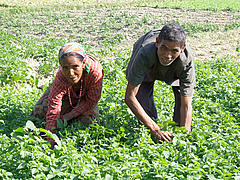To mark World Food Day on 16 October, we wanted to say a few words on the subject. Food is an increasingly serious environmental concern. Where it’s grown, how it’s grown – and how we can produce better food for people and nature. And no, it needn’t mean eating insects, but it could involve saving bees…
 As it says in our latest Living Planet Report, released this week: “Food is set to be the next major issue for the world.”
As it says in our latest Living Planet Report, released this week: “Food is set to be the next major issue for the world.”The reason it matters so much to us at WWF is that food production, land-use and the commercial and social pressures they bring have a direct impact on natural environments across the planet.
For instance, the massive global demand for palm oil and soya – versatile ingredients used in food, soaps, cosmetics and especially animal feed in the case of soya – has had severe consequences for some tropical landscapes and species.
Overfishing is another example. The quest for cheaper seafood has meant dangerous depletion of some species, and trawler damage to seabeds and coral reefs.
We’re helping improve working practices in all these areas, so people can still have the food (and the jobs) they need without so much impact on the planet.
The real food chain
Food tends to be unevenly distributed across the world, and in countries like ours an alarming amount is wasted and thrown away uneaten. Elsewhere, a billion people are going hungry.
Poor people in non-industrialised parts of the world generally rely more on local natural resources, so they suffer most if those resources are exploited for commercial use elsewhere. Hungry people are also more likely to use any and every natural resource they can. All of which can be bad news for local environments and the species living there.
As economies develop, a new set of problems can arise. When people get richer they tend to consume more calories, which has traditionally meant an increase in protein in the form of meat and dairy.
That's not a bad thing in itself, but to even out the demand on the world's resources, richer countries like ours may need to cut back a bit.
Huge amounts of land, feed crops and water is required to rear livestock. Conversion of vegetable-based calories to animal-based calories is inefficient, and in a resource-constrained world, we need to think about that equation.
For everyone to eat an Italian-style diet, for example, we’d need two planets’ worth of resources. We don’t have two. In fact, even if we all ate Malaysian-style diets, which are relatively low in meat and dairy, we’d still need 1.3 planets. So we’re all going to have to change our plans…
Alternative diets
Some have argued a completely animal-free diet is the way to go, but for most people this seems extreme. We think a more balanced and aware approach to our food supply can make a huge difference. In other words eating a little less meat, thinking about how it's produced, and wasting less of it.
If we’re determined to maintain a diet that’s high in animal protein, there may be other options too – some of them slightly outlandish, admittedly. Artificial meat made in laboratories, anyone? Or even bugs – there are plenty of them around. In some countries they’re already rediscovering the age-old culinary joys of insects.
It’s true – in Mexico, farmers who used to spend lots of money on pesticides to keep bugs off their crops have realised they can make more profits by collecting and selling the insects, candy-coated or fried. They’re nutritional too. Some bugs provide more protein, weight for weight, than beef.
We should definitely stop short of bees, though. Bees are vital for pollinating crops, and they’ve been declining in number in recent years. Imagine trying to do all that work by hand. It’s estimated those pollination services are worth around £120bn a year to the global economy. They say bees are responsible for one in three mouthfuls of our food.
Hungry world
The UN predicts a global population of between 7.8 billion and 10.9 billion people by 2050, and estimates food production will need to increase by 70% to feed them all.
Land use will be a big issue in coming years, even though technological advances in agriculture are likely to increase crop yields and hardiness – assuming the bees stick around to pollinate them.
We also need to include the land that might be used for producing biofuels. And there might not be enough water to irrigate all that extra food, unless we drastically improve the way we use it and slash waste. (Do you know how much water it takes to produce a kilo of beef, or a cup of coffee? Look it up – it’s frightening.)
And all that’s before we even consider the effects of global warming and climate change, which will cause more droughts and alter rainfall patterns in unpredictable ways.
Boosting world food production without gobbling up too much land and water will require new scientific and technological input. But it will also undoubtedly mean we need to change what we eat – and perhaps the whole way we think about food.
You can...
Support our current food campaign
Read an Ecologist piece on world diets by our CEO David Nussbaum

